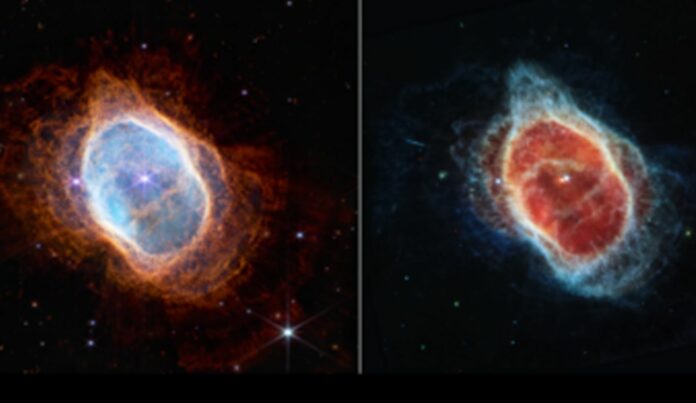They “were surprised to find evidence of two or three companion stars that probably hastened its death as well as one more ‘innocent bystander’ star that got caught up in the interaction.”
Around 2500 years ago, a star blew off most of its gas, making the stunning Southern Ring Nebula, NGC 3132, one of the first five image parcels from the James Webb Space Telescope (JWST).
A group of about 70 astronomers from 66 different places in Europe, North, South, and Central America, and Asia used images from the JWST to figure out how this star died.
“It was nearly three times the size of our Sun, but much younger, about 500 million years old. It created shrouds of gas that have expanded out from the ejection site, and left a remnant dense white dwarf star, with about half the mass of the Sun, but approximately the size of the Earth,” explains lead author Professor Orsola De Marco.
“We were surprised to find evidence of two or three companion stars that probably hastened its death as well as one more ‘innocent bystander’ star that got caught up in the interaction,” she adds.
The study used data from the ESO Very Large Telescope in Chile, the San Pedro de Martir Telescope in Mexico, the Gaia Space Telescope, and the Hubble Space Telescope in addition to the JWST images.
It makes it possible for JWST to study nebulae in the future. This will help scientists learn more about fundamental astrophysical processes, such as how winds collide and how two stars interact, which has implications for supernovae and gravitational wave systems.
The study was just published in Nature Astronomy.
“When we first saw the images, we knew we had to do something, we must investigate. The community came together and from this one image of a randomly chosen nebula we were able to discern much more precise structures than ever before. The promise of the James Webb Space Telescope is incredible,” points out Professor De Marco.
Astronomers collaborated online to formulate hypotheses and design models based on the mid-infrared picture in order to determine the exact cause of the star’s demise.
At the center of the nebula is a white dwarf that has burned up all of its hydrogen and is very hot.
“This star is now small and hot, but is surrounded by cool dust,” adds Joel Kastner, another team member, from the Rochester Institute of Technology USA. “We think all that gas and dust we see thrown all over the place must have come from that one star, but it was tossed in very specific directions by the companion stars.”
There are also structures that spiral out from the center. As the primary star loses mass, a companion orbiting it would produce these concentric arches. One more friend, farther away but still visible, may be seen in the background.
When the team looked at a three-dimensional reconstruction of the data, they also saw pairs of protuberances, which could happen when astronomical objects send out jets of material. These are irregular and radiate in various directions, potentially indicating a triple-star interaction at their center.
“We first inferred the presence of a close companion because of the dusty disk around the central star, the further partner that created the arches and the super far companion that you can see in the image,” add professor De Marco.
“Once we saw the jets, we knew there had to be another star or even two involved at the centre, so we believe there are one or two very close companions, an additional one at middle distance and one very far away. If this is the case, there are four or even five objects involved in this messy death.”
